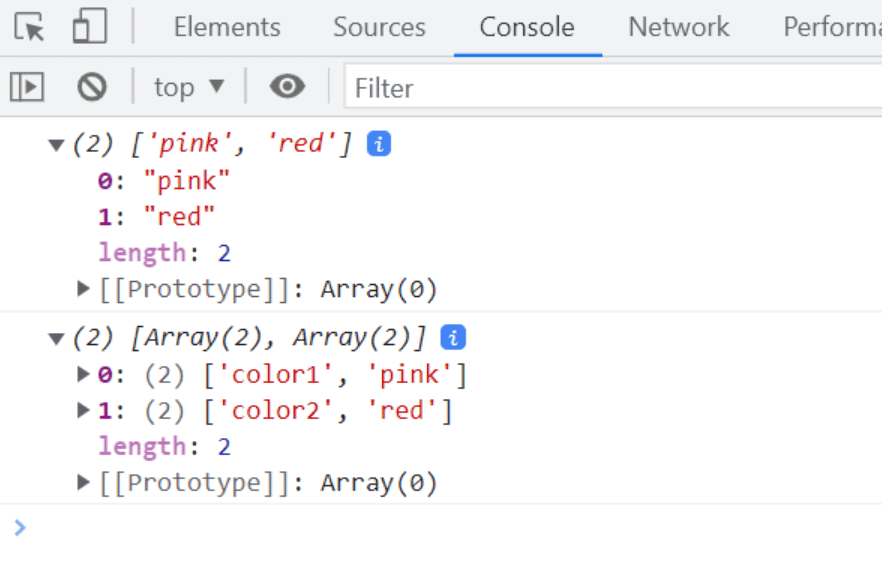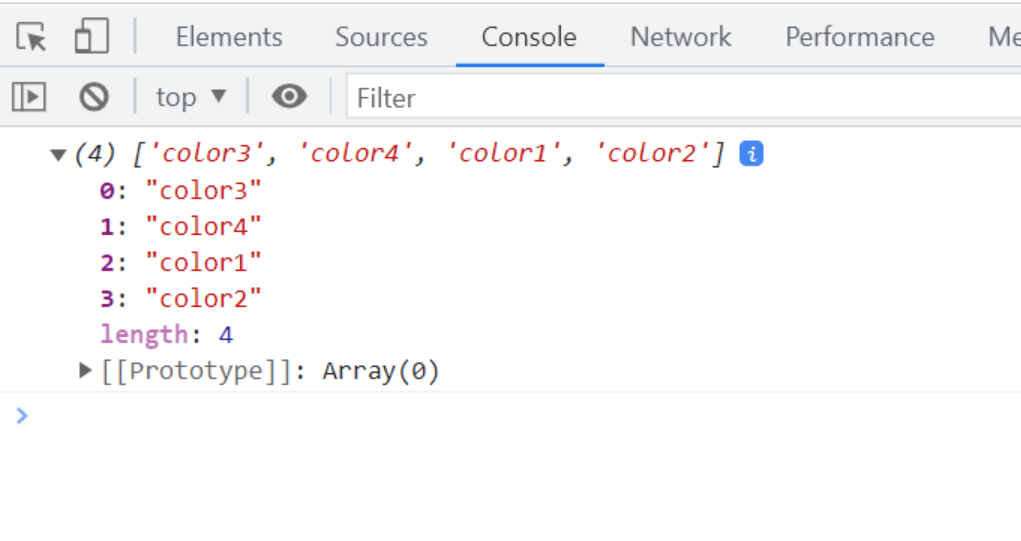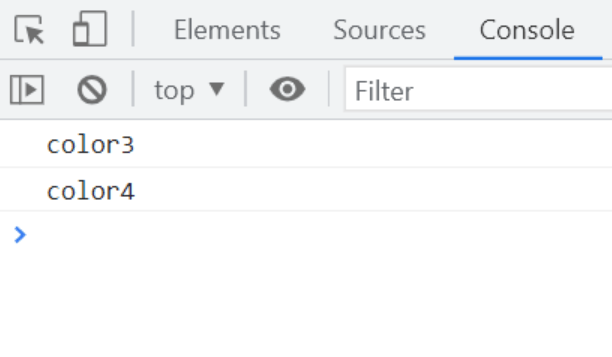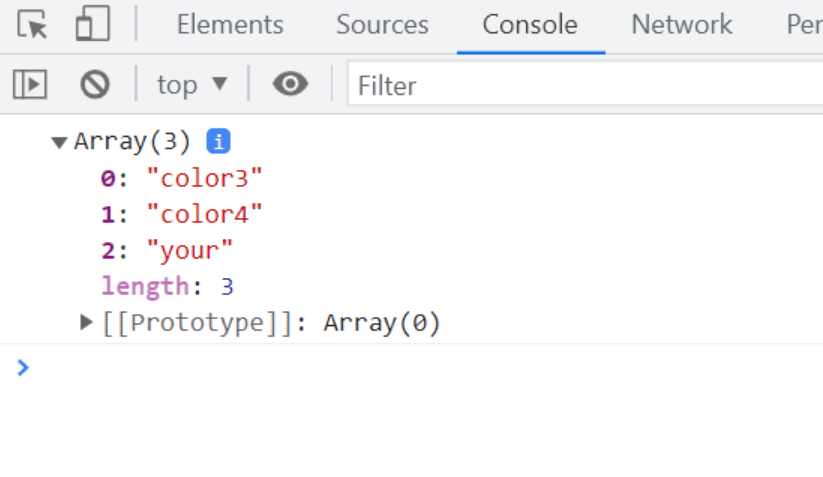JS获取对象key
傲娇味的草莓 人气:81、Object.keys()遍历自身可以枚举属性
let myColors = {
color1: 'pink',
color2: 'red'
};
let yourColors = {
color3: 'green',
color4: 'blue'
};
Object.setPrototypeOf(yourColors, myColors);
//setPrototypeOf()设置一个指定的对象的原型到另一个对象or NULL
Object.keys(myColors);
Object.keys(yourColors);
console.log(myColors);
console.log(yourColors);
console.log(myColors['color1']);
console.log(yourColors['color3']);
解析:Object.keys(myColors) 返回 myColors对象的自身可枚举属性键;Object.keys(yourColors)也是返回yourColors对象自身的可枚举属性键。setPrototypeOf()方法让yourColors继承myColors原型的属性,但是能看到并不能遍历出来。Object.keys() 是 遍历自身可以枚举属性。
2、Ojbect.values() /Ojject.entries()
返回自身可枚举属性的键值对数组:
let myColors = {
color1: 'pink',
color2: 'red'
};
let yourColors = {
color3: 'green',
color4: 'blue'
};
Object.setPrototypeOf(yourColors, myColors);
console.log(Object.values(myColors));
console.log(Object.entries(myColors));
3、for-in 遍历可枚举属性prototype 属性
for-in遍历对象所有的可枚举属性,包括原型。
ps:for-in和for-of的区别
①for in 遍历的是数组的索引(即键名),for of遍历的是数组元素值
②for in 得到对象的key or 数组 or 字符串的下标
③for of 得到对象的value or 数组 or 字符串的值
for in更适合遍历对象
let myColors = {
color1: 'pink',
color2: 'red'
};
let yourColors = {
color3: 'green',
color4: 'blue'
};
Object.setPrototypeOf(yourColors, myColors);
let arrayColors = [];
for (let key in yourColors) {
arrayColors.push(key);
}
console.log(arrayColors);

解析:arrayColors 数组 包含yourColors自身属性键,也有从原型对象myColrs继承的属性。
4、hasOwnProperty 遍历可枚举属性
返回一个布尔值,只能判断自有属性是否存在,对于继承属性会返回false,因为它不查找原型链的函数
//不使用hasOwnProperty,返回自身属性和继承原型属性
let myColors = {
color1: 'pink',
color2: 'red'
};
let yourColors = {
color3: 'green',
color4: 'blue'
};
Object.setPrototypeOf(yourColors, myColors);
for (let i in yourColors) {
console.log(i);
}
//使用hasOwnProperty,返回自身属性
let myColors = {
color1: 'pink',
color2: 'red'
};
let yourColors = {
color3: 'green',
color4: 'blue'
};
Object.setPrototypeOf(yourColors, myColors);
for (let i in yourColors) {
if (yourColors.hasOwnProperty(i)) { //加上if判断去掉原型链上的
console.log(i)
}
}
5、getOwnPropertyNames() 返回可枚举属性和不可枚举属性
不包括prototype属性,不包括symbol类型的key
getOwnPropertyNames()返回一个对象自身所有的属性,包括可枚举和不可枚举属性组成的数组
//返回对象自身所有的属性,可枚举和不可枚举组成的数组,但不包括prototype属性
let myColors = {
color1: 'pink',
color2: 'red'
};
let yourColors = {
color3: 'green',
color4: 'blue'
};
Object.setPrototypeOf(yourColors, myColors);
//定义不可枚举属性
Object.defineProperty(yourColors, 'your', {
enumerable: true,
value: 6,
})
console.log(Object.getOwnPropertyNames(yourColors));
//返回对象自身所有的属性,可枚举和不可枚举组成的数组,但不包括Symbol类型的key
let _item = Symbol('item') //定义Symbol数据类型
let myColors = {
color1: 'pink',
color2: 'red',
};
let yourColors = {
color3: 'green',
color4: 'blue',
[_item]: 'mySymbol'
};
Object.setPrototypeOf(yourColors, myColors);
//定义不可枚举属性
Object.defineProperty(yourColors, 'your', {
enumerable: true,
value: 6,
})
console.log(Object.getOwnPropertyNames(yourColors));
6、getOwnPropertySymbols() 返回symbol类型的key属性,
不关心是否可枚举,返回对象自身的所有Symbol属性组成的数组
let _item = Symbol('item') //定义Symbol数据类型
let myColors = {
color1: 'pink',
color2: 'red',
};
let yourColors = {
color3: 'green',
color4: 'blue',
[_item]: 'mySymbol'
};
Object.setPrototypeOf(yourColors, myColors);
//定义不可枚举属性
Object.defineProperty(yourColors, 'your', {
enumerable: true,
value: 6,
})
console.log(Object.getOwnPropertySymbols(yourColors));
7、对象对key的获取方法
function getkey() {
let obj = {
a: 1,
b: 2,
c: 3
};
Object.prototype.d = 4;
Object.defineProperty(obj, 'e', {
configurable: true,
writable: false,
enumerable: false,
value: 5
});
Object.defineProperty(obj, 'f', {
configurable: true,
writable: false,
enumerable: true,
value: 6
});
const symbolg = Symbol('g');
const symbolh = Symbol('h');
Object.defineProperty(obj, symbolg, {
configurable: true,
writable: false,
enumerable: false,
value: 7
});
Object.defineProperty(obj, symbolh, {
configurable: true,
writable: false,
enumerable: true,
value: 8
});
console.log();
for (let key in obj) {
console.log('-- for-in:', key);
if (obj.hasOwnProperty(key)) {
console.log('-- hasOwnProperty: ', key);
}
}
console.log('-- getOwnPropertyNames: ', Object.getOwnPropertyNames(obj));
console.log('-- getOwnPropertyDescriptor: ', Object.getOwnPropertyDescriptor(obj));
console.log('-- getOwnPropertySymbols: ', Object.getOwnPropertySymbols(obj));
console.log('-- keys: ', Object.keys(obj));
}
/***
*
-- for-in: a
-- hasOwnProperty: a
-- for-in: b
-- hasOwnProperty: b
-- for-in: c
-- hasOwnProperty: c
-- for-in: f
-- hasOwnProperty: f
-- for-in: d
-- getOwnPropertyNames: (5) ["a", "b", "c", "e", "f"]
-- getOwnPropertyDescriptor: undefined (可获取对象属性的具体配置,总共是6个)
-- getOwnPropertySymbols: (2) [Symbol(g), Symbol(h)]
-- keys: (4) ["a", "b", "c", "f"]
*/8、对象声明/对象赋值
/**
* 对象声明
* 首选 {}
*
* 对象赋值
* 首选 对象内赋值
*/
function getKey(flag) {
return `uniqued key ${flag}`;
}
const obj = {
id: 5,
name: 'San Francisco',
[getKey('enabled')]: true, // 可变key提前声明
};9、对象扩展
/** * * 对象 扩展 * * object assign 对象扩展 * 每次执行 assign * 事实上是对 object 原来对象的扩展然后并返回这个新的对象,
加载全部内容
- 猜你喜欢
- 用户评论